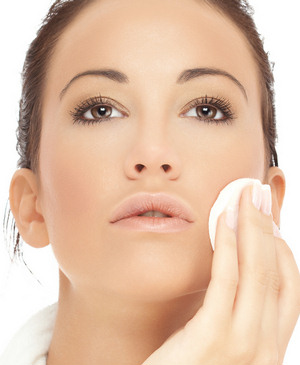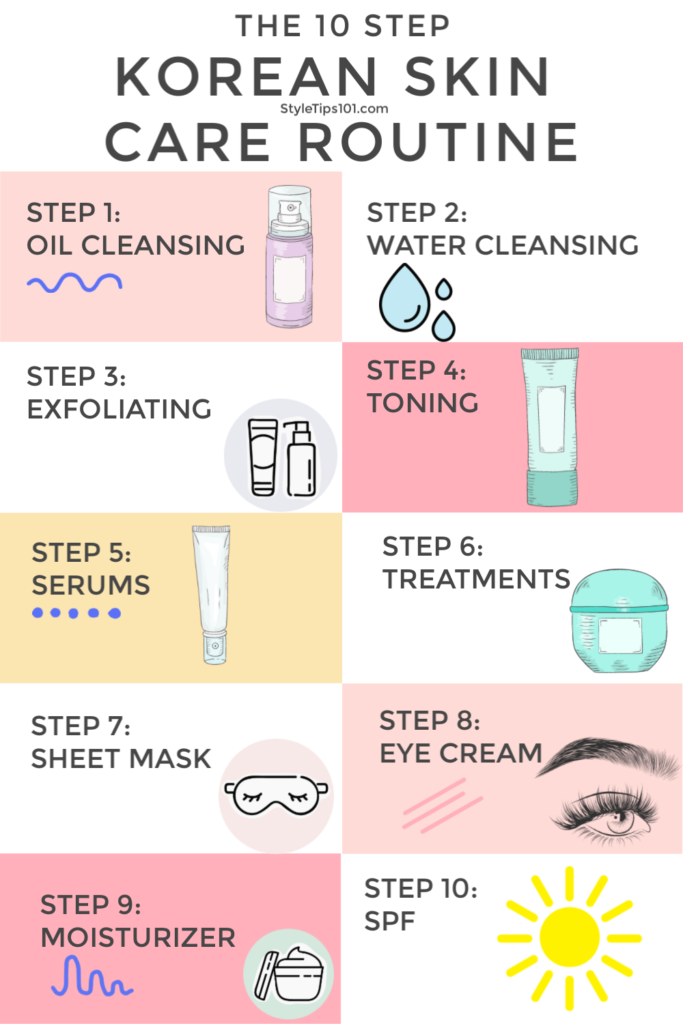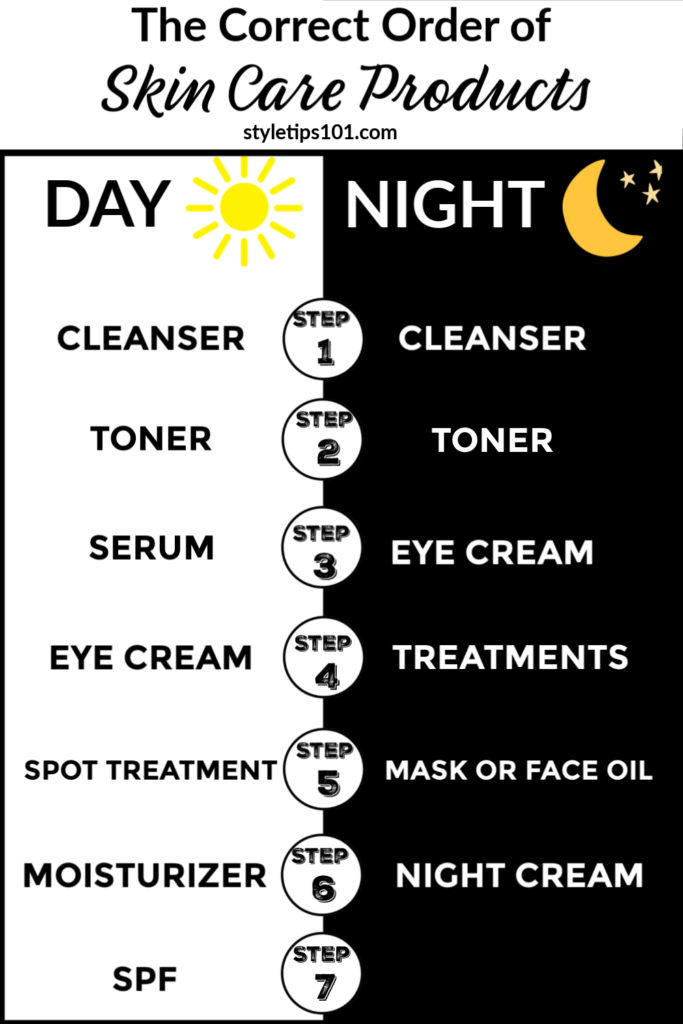What IS the correct order of skin care products? Does it matter if you apply eye cream before moisturizer, or should it be the other way around? We’re here to answer all of these questions and more!

Have you ever just stood there in a drug store starring at the hundreds of products and wondered, how in the world does anyone have time to apply all of these products? Or rather, which order do they even go in? It may seem like common sense at first, but the truth of the matter is that even skin care aficionados can get confused from time to time.
Every single day, more and more skin care products are being added to shelves. And this can leave us a little bit bamboozled. There is everything from facial cleansers, to toners, to scrubs, AM and PM moisturizes, serums, eye creams, SPF, and a slew of other skin care products. It’s enough to make your head spin!
Do you NEED to apply all of these products, and if so, what is the correct order of skin care products? In this article, we’ll be exploring the following questions and concerns:
- What is the Correct Order of Skin Care Products?
- What is the best skin care routine for the night?
- What do AM and PM mean on skin care products?
- Does the Korean 10-step skin care routine really work or help?
- What is the most effective skin care routine?
The Correct Order of Skin Care Products
In What Order do I Apply My Skin Care Products?
The order in which you apply your skin care products really DOES matter! According to expert dermatologists, applying your skin care products in the correct order ensures that your skin receives the maximum benefit of each product.
A lot of skin care products are made to penetrate the skin, and therefore give the skin what it ultimately needs. If these products are not layered correctly and in the right order, they cannot properly penetrate the skin.
A good rule of thumb to go by is to apply your skin care products from the thinnest consistency to the thickest consistency, so liquid to oil.
Treatment products such as retinol and peel pads should be left off for your night time skin care routine so that they have the entire night to work.
Day Time Skin Care Routine
Step 1: Cleanser
Choose a cleanser that’s designed for your skin type. For example, if you have oily and/or acne prone skin, wash your face with an acne-targeted facial cleanser such as Neutrogena Oil Free Acne Wash. Start by splashing your face with warm water and apply a small amount of the cleanser into your hands. Rub your face in slow, circular motions. Rinse off and pat dry.
Step 2: Toner
Again, choose a toner that’s designed for your skin type. Although toners were thought to be useless for the skin, that is not the case anymore. Toners have come a long way, and keep help balance the skin’s pH, help beauty products to better absorb into the skin, deliver nutrients to the skin, and remove any leftover dirt or debris your facial cleanser may have missed.
Step 3: Serum
A serum is a crucial part of any beauty regimen, especially for those with aging skin. Serums are generally super concentrated skin nutrients that target specific skin concerns. For daytime, you should use an antioxidant serum which protect your skin from the sun’s harmful UV rays as well as environmental pollutants.
Step 4: Eye Cream
An eye cream is an extremely important part of any skin care routine, especially starting in your 20s. The skin around the eye is the thinnest part of the skin on your face, and therefore will start loosing elasticity first. It’s crucial that you apply a good quality eye cream every night before bed or even in the mornings to keep the skin thick and taut. Try using an eye cream with an SPF, which can further protect the delicate skin around the eyes.
Step 5: Spot Treatments
Prescription spot treatments such as a acne treatments should be applied every day. Depending on what type of treatment you’re using, it’s best to speak to your dermatologist about how exactly to apply the treatment and how often.
Step 6: Moisturizer
Applying a moisturizer is crucial, even if you have oily skin. For best results, choose a moisturizer to fit your skin type. Those with acne and oily prone skin, should opt for gel-based moisturizers. Massage the moisturizer gently into the skin in slow, circular motions. If you’ve applied a spot treatment, do not apply moisturizer on top of the treatment.
Step 7: SPF
Last, but certainly not least, is the all important, but always forgotten SPF. A good SPF can save your skin from the sun’s harmful UV rays and protect it against damage. Use a sunscreen that contains zinc and apply it every day after your moisturizer to ensure good, healthy skin and prevent future sun damage.
Night Time Skin Care Routine
Step 1: Double Cleansing
Double cleansing involves cleansing your face twice. There are two different ways in which you can do this:
- Using makeup removing towelettes to first remove dirt, grime, and makeup and THEN using a facial cleanser.
- Using a cleansing oil to remove dirt, grime, and makeup, and THEN using a facial cleanser.
There is no wrong choice, so choose whichever method works best for you. Double cleansing ensures that you get rid of all the makeup and dirt, and that the rest of your products can easily penetrate the skin.
Step 2: Toners and Boosters
Next, apply a toner that’s designed for your skin type. At this point, you can also massage in any boosters or water-based beauty products such as hyaluronic serums or a rose water mist. This step will help nourish and hydrate the skin, remove any leftover debris, and prep the skin for upcoming products.
Step 4: Eye Cream
Just like in the mornings, you should also apply eye cream in the evening. Doing this right after using a toner or booster will protect the delicate eye area from other beauty products, which can sometimes be harsh.
Step 5: Treatments, Serums, and Other Targeted Products
If you suffer from acne or other skin conditions, now would be a good time to layer those products on. Be mindful that less is also more, so don’t apply too many products – try to stick to one product that you actually need. So if you have an acne prone area, apply a treatment only on that area and nothing else.
Step 6: Hydrating Mask Or Face Oil
If you have dry skin, consider using a hydrating mask or a face oil to hydrate dry, parched skin. Those with oily and acne prone skin can skin this step.
Step 7: Moisturizer/Night Cream
While you may think that using the same moisturizer during the day as you do at night is ok, it’s actually not the best idea. Night moisturizers are thicker and are made to be absorbed over the course of several hours. Night moisturizers create a protective coating on the skin which prevents water from evaporating while you sleep.
What do AM and PM Mean on Skin Care Products?
AM skin care products are designed to be used in the mornings and during the day time. This means they are much lighter in consistency, and therefore are meant to be absorbed much quicker.
PM skin care products are for night time use, and are much thicker in consistency than AM products. This is because PM products are time-released and need several hours to slowly melt into the skin.
Does the Korean 10-Step Skin Care Routine Really Work or Help?

If you already have great skin, there really is no need to change your routine from what it already is. Like the saying goes…if it ain’t broke, don’t fix it!
But, if you have problem skin, such as acne prone, dry, oily, etc, the 10 step Korean skin care routine may just help! Although you need to have some patience with this (after all, 10 steps is quite a bit), it’s totally worth it!
The Korean 10 step skin care routine aims to deeply cleanse, tone, and hydrate the skin, leaving it baby smooth after just one use.
Learn more about the 10-step Korean skin care routine!
What is the Most Effective Skin Care Routine?
There is no such thing as the perfect or most effective skin care routine, but rather the most effective skin care routine for YOU. Every person’s body is different, and that means that every skin is also different.
Your skin may react differently than someone else’s, so your best course of action would be to try different things and see what works for you. Listen to your skin, see what it needs, and pay attention to the signs. Eventually, you’ll know what your skin loves and what it doesn’t.
Like this post? Share, Pin, and Comment Below 🙂

